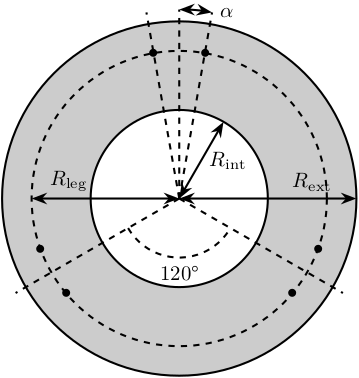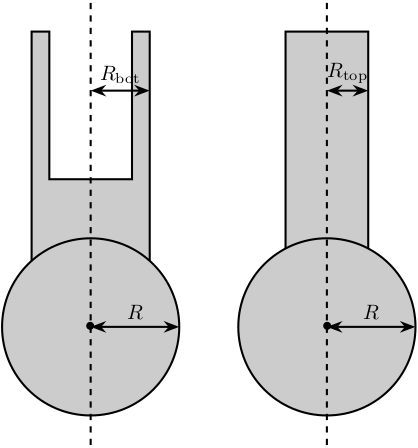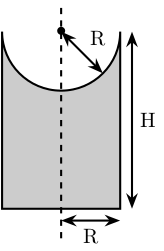24 KiB
Stewart Platform - Simscape Model
- Introduction
- Procedure
- Matlab Code
- initializeCubicConfiguration
- initializeGeneralConfiguration
- computeGeometricalProperties
- initializeMechanicalElements
- initializeSample
Introduction ignore
Stewart platforms are generated in multiple steps.
We define 4 important frames:
- $\{F\}$: Frame fixed to the Fixed base and located at the center of its bottom surface. This is used to fix the Stewart platform to some support.
- $\{M\}$: Frame fixed to the Moving platform and located at the center of its top surface. This is used to place things on top of the Stewart platform.
- $\{A\}$: Frame fixed to the fixed base. It defined the center of rotation of the moving platform.
- $\{B\}$: Frame fixed to the moving platform. The motion of the moving platforms and forces applied to it are defined with respect to this frame $\{B\}$.
Then, we define the location of the spherical joints:
- $\bm{a}_{i}$ are the position of the spherical joints fixed to the fixed base
- $\bm{b}_{i}$ are the position of the spherical joints fixed to the moving platform
We define the rest position of the Stewart platform:
- For simplicity, we suppose that the fixed base and the moving platform are parallel and aligned with the vertical axis at their rest position.
- Thus, to define the rest position of the Stewart platform, we just have to defined its total height $H$. $H$ corresponds to the distance from the bottom of the fixed base to the top of the moving platform.
From $\bm{a}_{i}$ and $\bm{b}_{i}$, we can determine the length and orientation of each strut:
- $l_{i}$ is the length of the strut
- ${}^{A}\hat{\bm{s}}_{i}$ is the unit vector align with the strut
The position of the Spherical joints can be done using various methods:
- Cubic configuration
- Geometrical
- Definition them by hand
- These methods should be easily scriptable and corresponds to specific functions that returns ${}^{F}\bm{a}_{i}$ and ${}^{M}\bm{b}_{i}$. The input of these functions are the parameters corresponding to the wanted geometry. We need also to know the height of the platform.
For Simscape, we need:
- The position of the frame $\{A\}$ with respect to the frame $\{F\}$: ${}^{F}\bm{O}_{A}$
- The position of the frame $\{B\}$ with respect to the frame $\{M\}$: ${}^{M}\bm{O}_{B}$
- The position and orientation of each spherical joint fixed to the fixed base: ${}^{F}\bm{a}_{i}$ and ${}^{F}\bm{R}_{a_{i}}$
- The position and orientation of each spherical joint fixed to the moving platform: ${}^{M}\bm{b}_{i}$ and ${}^{M}\bm{R}_{b_{i}}$
- The rest length of each strut: $l_{i}$
- The stiffness and damping of each actuator: $k_{i}$ and $c_{i}$
Procedure
The procedure is the following:
- Choose $H$
- Choose ${}^{F}\bm{O}_{A}$ and ${}^{M}\bm{O}_{B}$
- Choose $\bm{a}_{i}$ and $\bm{b}_{i}$, probably by specifying ${}^{F}\bm{a}_{i}$ and ${}^{M}\bm{b}_{i}$
- Choose $k_{i}$ and $c_{i}$
Matlab Code
Simscape Model
open('stewart_platform.slx')Define the Height of the Platform
%% 1. Height of the platform. Location of {F} and {M}
H = 90e-3; % [m]
FO_M = [0; 0; H];Define the location of {A} and {B}
%% 2. Location of {A} and {B}
FO_A = [0; 0; 100e-3] + FO_M;% [m,m,m]
MO_B = [0; 0; 100e-3];% [m,m,m]Define the position of $a_{i}$ and $b_{i}$
%% 3. Position of ai and bi
Fa = zeros(3, 6); % Fa_i is the i'th vector of Fa
Mb = zeros(3, 6); % Mb_i is the i'th vector of Mb Aa = Fa - repmat(FO_A, [1, 6]);
Bb = Mb - repmat(MO_B, [1, 6]);
Ab = Bb - repmat(-MO_B-FO_M+FO_A, [1, 6]);
Ba = Aa - repmat( MO_B+FO_M-FO_A, [1, 6]);
As = (Ab - Aa)./vecnorm(Ab - Aa); % As_i is the i'th vector of As
l = vecnorm(Ab - Aa);
Bs = (Bb - Ba)./vecnorm(Bb - Ba);
FRa = zeros(3,3,6);
MRb = zeros(3,3,6);
for i = 1:6
FRa(:,:,i) = [cross([0;1;0],As(:,i)) , cross(As(:,i), cross([0;1;0], As(:,i))) , As(:,i)];
FRa(:,:,i) = FRa(:,:,i)./vecnorm(FRa(:,:,i));
MRb(:,:,i) = [cross([0;1;0],Bs(:,i)) , cross(Bs(:,i), cross([0;1;0], Bs(:,i))) , Bs(:,i)];
MRb(:,:,i) = MRb(:,:,i)./vecnorm(MRb(:,:,i));
endDefine the dynamical properties of each strut
%% 4. Stiffness and Damping of each strut
Ki = 1e6*ones(6,1);
Ci = 1e2*ones(6,1);Old Introduction ignore
First, geometrical parameters are defined:
- ${}^A\bm{a}_i$ - Position of the joints fixed to the fixed base w.r.t $\{A\}$
- ${}^A\bm{b}_i$ - Position of the joints fixed to the mobile platform w.r.t $\{A\}$
- ${}^B\bm{b}_i$ - Position of the joints fixed to the mobile platform w.r.t $\{B\}$
- $H$ - Total height of the mobile platform
These parameter are enough to determine all the kinematic properties of the platform like the Jacobian, stroke, stiffness, …
These geometrical parameters can be generated using different functions: initializeCubicConfiguration for cubic configuration or initializeGeneralConfiguration for more general configuration.
A function computeGeometricalProperties is then used to compute:
- $\bm{J}_f$ - Jacobian matrix for the force location
- $\bm{J}_d$ - Jacobian matrix for displacement estimation
- $\bm{R}_m$ - Rotation matrices to position the leg vectors
Then, geometrical parameters are computed for all the mechanical elements with the function initializeMechanicalElements:
-
Shape of the platforms
- External Radius
- Internal Radius
- Density
- Thickness
-
Shape of the Legs
- Radius
- Size of ball joint
- Density
Other Parameters are defined for the Simscape simulation:
- Sample mass, volume and position (
initializeSamplefunction) - Location of the inertial sensor
- Location of the point for the differential measurements
- Location of the Jacobian point for velocity/displacement computation
Cubic Configuration
To define the cubic configuration, we need to define 4 parameters:
- The size of the cube
- The location of the cube
- The position of the plane joint the points $a_{i}$
- The position of the plane joint the points $b_{i}$
To do so, we specify the following parameters:
- $H_{C}$ the height of the useful part of the cube
- ${}^{F}O_{C}$ the position of the center of the cube with respect to $\{F\}$
- ${}^{F}H_{A}$: the height of the plane joining the points $a_{i}$ with respect to the frame $\{F\}$
- ${}^{M}H_{B}$: the height of the plane joining the points $b_{i}$ with respect to the frame $\{B\}$
We define the parameters
Hc = 60e-3; % [m]
FOc = 50e-3; % [m]
FHa = 15e-3; % [m]
MHb = 15e-3; % [m]We define the useful points of the cube with respect to the Cube's center. ${}^{C}C$ are the 6 vertices of the cubes expressed in a frame {C} which is located at the center of the cube and aligned with {F} and {M}.
sx = [ 2; -1; -1];
sy = [ 0; 1; -1];
sz = [ 1; 1; 1];
R = [sx, sy, sz]./vecnorm([sx, sy, sz]);
L = Hc*sqrt(3);
Cc = R'*[[0;0;L],[L;0;L],[L;0;0],[L;L;0],[0;L;0],[0;L;L]] - [0;0;1.5*Hc];
CCf = [Cc(:,1), Cc(:,3), Cc(:,3), Cc(:,5), Cc(:,5), Cc(:,1)]; % CCf(:,i) corresponds to the bottom cube's vertice corresponding to the i'th leg
CCm = [Cc(:,2), Cc(:,2), Cc(:,4), Cc(:,4), Cc(:,6), Cc(:,6)]; % CCm(:,i) corresponds to the top cube's vertice corresponding to the i'th legWe can compute the vector of each leg ${}^{C}\hat{\bm{s}}_{i}$ (unit vector from ${}^{C}C_{f}$ to ${}^{C}C_{m}$).
CSi = (CCm - CCf)./vecnorm(CCm - CCf);We now which to compute the position of the joints $a_{i}$ and $b_{i}$.
Fa = zeros(3, 6); % Fa_i is the i'th vector of Fa
Mb = zeros(3, 6); % Mb_i is the i'th vector of Mb Fa = CCf + [0; 0; FOc] + ((FHa-(FOc-Hc/2))./CSi(3,:)).*CSi;
Mb = CCf + [0; 0; FOc-H] + ((H-MHb-(FOc-Hc/2))./CSi(3,:)).*CSi; % TODOinitializeCubicConfiguration
<<sec:initializeCubicConfiguration>>
Function description
function [stewart] = initializeCubicConfiguration(opts_param)Optional Parameters
Default values for opts.
opts = struct(...
'H_tot', 90, ... % Total height of the Hexapod [mm]
'L', 110, ... % Size of the Cube [mm]
'H', 40, ... % Height between base joints and platform joints [mm]
'H0', 75 ... % Height between the corner of the cube and the plane containing the base joints [mm]
);Populate opts with input parameters
if exist('opts_param','var')
for opt = fieldnames(opts_param)'
opts.(opt{1}) = opts_param.(opt{1});
end
endCube Creation
points = [0, 0, 0; ...
0, 0, 1; ...
0, 1, 0; ...
0, 1, 1; ...
1, 0, 0; ...
1, 0, 1; ...
1, 1, 0; ...
1, 1, 1];
points = opts.L*points;We create the rotation matrix to rotate the cube
sx = cross([1, 1, 1], [1 0 0]);
sx = sx/norm(sx);
sy = -cross(sx, [1, 1, 1]);
sy = sy/norm(sy);
sz = [1, 1, 1];
sz = sz/norm(sz);
R = [sx', sy', sz']';We use to rotation matrix to rotate the cube
cube = zeros(size(points));
for i = 1:size(points, 1)
cube(i, :) = R * points(i, :)';
endVectors of each leg
leg_indices = [3, 4; ...
2, 4; ...
2, 6; ...
5, 6; ...
5, 7; ...
3, 7];Vectors are:
legs = zeros(6, 3);
legs_start = zeros(6, 3);
for i = 1:6
legs(i, :) = cube(leg_indices(i, 2), :) - cube(leg_indices(i, 1), :);
legs_start(i, :) = cube(leg_indices(i, 1), :);
endVerification of Height of the Stewart Platform
If the Stewart platform is not contained in the cube, throw an error.
Hmax = cube(4, 3) - cube(2, 3);
if opts.H0 < cube(2, 3)
error(sprintf('H0 is not high enought. Minimum H0 = %.1f', cube(2, 3)));
else if opts.H0 + opts.H > cube(4, 3)
error(sprintf('H0+H is too high. Maximum H0+H = %.1f', cube(4, 3)));
error('H0+H is too high');
endDeterminate the location of the joints
We now determine the location of the joints on the fixed platform w.r.t the fixed frame $\{A\}$. $\{A\}$ is fixed to the bottom of the base.
Aa = zeros(6, 3);
for i = 1:6
t = (opts.H0-legs_start(i, 3))/(legs(i, 3));
Aa(i, :) = legs_start(i, :) + t*legs(i, :);
endAnd the location of the joints on the mobile platform with respect to $\{A\}$.
Ab = zeros(6, 3);
for i = 1:6
t = (opts.H0+opts.H-legs_start(i, 3))/(legs(i, 3));
Ab(i, :) = legs_start(i, :) + t*legs(i, :);
endAnd the location of the joints on the mobile platform with respect to $\{B\}$.
Bb = zeros(6, 3);
Bb = Ab - (opts.H0 + opts.H_tot/2 + opts.H/2)*[0, 0, 1]; h = opts.H0 + opts.H/2 - opts.H_tot/2;
Aa = Aa - h*[0, 0, 1];
Ab = Ab - h*[0, 0, 1];Returns Stewart Structure
stewart = struct();
stewart.Aa = Aa;
stewart.Ab = Ab;
stewart.Bb = Bb;
stewart.H_tot = opts.H_tot;
endinitializeGeneralConfiguration
Function description
The initializeGeneralConfiguration function takes one structure that contains configurations for the hexapod and returns one structure representing the Hexapod.
function [stewart] = initializeGeneralConfiguration(opts_param)Optional Parameters
Default values for opts.
opts = struct(...
'H_tot', 90, ... % Height of the platform [mm]
'H_joint', 15, ... % Height of the joints [mm]
'H_plate', 10, ... % Thickness of the fixed and mobile platforms [mm]
'R_bot', 100, ... % Radius where the legs articulations are positionned [mm]
'R_top', 80, ... % Radius where the legs articulations are positionned [mm]
'a_bot', 10, ... % Angle Offset [deg]
'a_top', 40, ... % Angle Offset [deg]
'da_top', 0 ... % Angle Offset from 0 position [deg]
);Populate opts with input parameters
if exist('opts_param','var')
for opt = fieldnames(opts_param)'
opts.(opt{1}) = opts_param.(opt{1});
end
endCompute Aa and Ab
We compute $[a_1, a_2, a_3, a_4, a_5, a_6]^T$ and $[b_1, b_2, b_3, b_4, b_5, b_6]^T$.
Aa = zeros(6, 3); % [mm]
Ab = zeros(6, 3); % [mm]
Bb = zeros(6, 3); % [mm] for i = 1:3
Aa(2*i-1,:) = [opts.R_bot*cos( pi/180*(120*(i-1) - opts.a_bot) ), ...
opts.R_bot*sin( pi/180*(120*(i-1) - opts.a_bot) ), ...
opts.H_plate+opts.H_joint];
Aa(2*i,:) = [opts.R_bot*cos( pi/180*(120*(i-1) + opts.a_bot) ), ...
opts.R_bot*sin( pi/180*(120*(i-1) + opts.a_bot) ), ...
opts.H_plate+opts.H_joint];
Ab(2*i-1,:) = [opts.R_top*cos( pi/180*(120*(i-1) + opts.da_top - opts.a_top) ), ...
opts.R_top*sin( pi/180*(120*(i-1) + opts.da_top - opts.a_top) ), ...
opts.H_tot - opts.H_plate - opts.H_joint];
Ab(2*i,:) = [opts.R_top*cos( pi/180*(120*(i-1) + opts.da_top + opts.a_top) ), ...
opts.R_top*sin( pi/180*(120*(i-1) + opts.da_top + opts.a_top) ), ...
opts.H_tot - opts.H_plate - opts.H_joint];
end
Bb = Ab - opts.H_tot*[0,0,1];Returns Stewart Structure
stewart = struct();
stewart.Aa = Aa;
stewart.Ab = Ab;
stewart.Bb = Bb;
stewart.H_tot = opts.H_tot;
endcomputeGeometricalProperties
Function description
function [stewart] = computeGeometricalProperties(stewart, opts_param)Optional Parameters
Default values for opts.
opts = struct(...
'Jd_pos', [0, 0, 30], ... % Position of the Jacobian for displacement estimation from the top of the mobile platform [mm]
'Jf_pos', [0, 0, 30] ... % Position of the Jacobian for force location from the top of the mobile platform [mm]
);Populate opts with input parameters
if exist('opts_param','var')
for opt = fieldnames(opts_param)'
opts.(opt{1}) = opts_param.(opt{1});
end
endRotation matrices
We initialize $l_i$ and $\hat{s}_i$
leg_length = zeros(6, 1); % [mm]
leg_vectors = zeros(6, 3);We compute $b_i - a_i$, and then:
\begin{align*} l_i &= \left|b_i - a_i\right| \\ \hat{s}_i &= \frac{b_i - a_i}{l_i} \end{align*} legs = stewart.Ab - stewart.Aa;
for i = 1:6
leg_length(i) = norm(legs(i,:));
leg_vectors(i,:) = legs(i,:) / leg_length(i);
endWe compute rotation matrices to have the orientation of the legs. The rotation matrix transforms the $z$ axis to the axis of the leg. The other axis are not important here.
stewart.Rm = struct('R', eye(3));
for i = 1:6
sx = cross(leg_vectors(i,:), [1 0 0]);
sx = sx/norm(sx);
sy = -cross(sx, leg_vectors(i,:));
sy = sy/norm(sy);
sz = leg_vectors(i,:);
sz = sz/norm(sz);
stewart.Rm(i).R = [sx', sy', sz'];
endJacobian matrices
Compute Jacobian Matrix
Jd = zeros(6);
for i = 1:6
Jd(i, 1:3) = leg_vectors(i, :);
Jd(i, 4:6) = cross(0.001*(stewart.Bb(i, :) - opts.Jd_pos), leg_vectors(i, :));
end
stewart.Jd = Jd;
stewart.Jd_inv = inv(Jd); Jf = zeros(6);
for i = 1:6
Jf(i, 1:3) = leg_vectors(i, :);
Jf(i, 4:6) = cross(0.001*(stewart.Bb(i, :) - opts.Jf_pos), leg_vectors(i, :));
end
stewart.Jf = Jf;
stewart.Jf_inv = inv(Jf); endinitializeMechanicalElements
Function description
function [stewart] = initializeMechanicalElements(stewart, opts_param)Optional Parameters
Default values for opts.
opts = struct(...
'thickness', 10, ... % Thickness of the base and platform [mm]
'density', 1000, ... % Density of the material used for the hexapod [kg/m3]
'k_ax', 1e8, ... % Stiffness of each actuator [N/m]
'c_ax', 1000, ... % Damping of each actuator [N/(m/s)]
'stroke', 50e-6 ... % Maximum stroke of each actuator [m]
);Populate opts with input parameters
if exist('opts_param','var')
for opt = fieldnames(opts_param)'
opts.(opt{1}) = opts_param.(opt{1});
end
endBottom Plate

The bottom plate structure is initialized.
BP = struct();We defined its internal radius (if there is a hole in the bottom plate) and its outer radius.
BP.Rint = 0; % Internal Radius [mm]
BP.Rext = 150; % External Radius [mm]We define its thickness.
BP.H = opts.thickness; % Thickness of the Bottom Plate [mm]We defined the density of the material of the bottom plate.
BP.density = opts.density; % Density of the material [kg/m3]And its color.
BP.color = [0.7 0.7 0.7]; % Color [RGB]Then the profile of the bottom plate is computed and will be used by Simscape
BP.shape = [BP.Rint BP.H; BP.Rint 0; BP.Rext 0; BP.Rext BP.H]; % [mm]The structure is added to the stewart structure
stewart.BP = BP;Top Plate
The top plate structure is initialized.
TP = struct();We defined the internal and external radius of the top plate.
TP.Rint = 0; % [mm]
TP.Rext = 100; % [mm]The thickness of the top plate.
TP.H = 10; % [mm]The density of its material.
TP.density = opts.density; % Density of the material [kg/m3]Its color.
TP.color = [0.7 0.7 0.7]; % Color [RGB]Then the shape of the top plate is computed
TP.shape = [TP.Rint TP.H; TP.Rint 0; TP.Rext 0; TP.Rext TP.H];The structure is added to the stewart structure
stewart.TP = TP;Legs

The leg structure is initialized.
Leg = struct();The maximum Stroke of each leg is defined.
Leg.stroke = opts.stroke; % [m]The stiffness and damping of each leg are defined
Leg.k_ax = opts.k_ax; % Stiffness of each leg [N/m]
Leg.c_ax = opts.c_ax; % Damping of each leg [N/(m/s)]The radius of the legs are defined
Leg.Rtop = 10; % Radius of the cylinder of the top part of the leg[mm]
Leg.Rbot = 12; % Radius of the cylinder of the bottom part of the leg [mm]The density of its material.
Leg.density = opts.density; % Density of the material used for the legs [kg/m3]Its color.
Leg.color = [0.5 0.5 0.5]; % Color of the top part of the leg [RGB]The radius of spheres representing the ball joints are defined.
Leg.R = 1.3*Leg.Rbot; % Size of the sphere at the extremity of the leg [mm]We estimate the length of the legs.
legs = stewart.Ab - stewart.Aa;
Leg.lenght = norm(legs(1,:))/1.5;Then the shape of the bottom leg is estimated
Leg.shape.bot = ...
[0 0; ...
Leg.Rbot 0; ...
Leg.Rbot Leg.lenght; ...
Leg.Rtop Leg.lenght; ...
Leg.Rtop 0.2*Leg.lenght; ...
0 0.2*Leg.lenght];The structure is added to the stewart structure
stewart.Leg = Leg;Ball Joints

SP is the structure representing the support for the ball joints at the extremity of each leg.
The SP structure is initialized.
SP = struct();We can define its rotational stiffness and damping. For now, we use perfect joints.
SP.k = 0; % [N*m/deg]
SP.c = 0; % [N*m/deg]Its height is defined
SP.H = stewart.Aa(1, 3) - BP.H; % [mm]Its radius is based on the radius on the sphere at the end of the legs.
SP.R = Leg.R; % [mm] SP.section = [0 SP.H-SP.R;
0 0;
SP.R 0;
SP.R SP.H];The density of its material is defined.
SP.density = opts.density; % [kg/m^3]Its color is defined.
SP.color = [0.7 0.7 0.7]; % [RGB]The structure is added to the Hexapod structure
stewart.SP = SP;initializeSample
Function description
function [] = initializeSample(opts_param)Optional Parameters
Default values for opts.
sample = struct( ...
'radius', 100, ... % radius of the cylinder [mm]
'height', 100, ... % height of the cylinder [mm]
'mass', 10, ... % mass of the cylinder [kg]
'measheight', 50, ... % measurement point z-offset [mm]
'offset', [0, 0, 0], ... % offset position of the sample [mm]
'color', [0.9 0.1 0.1] ...
);Populate opts with input parameters
if exist('opts_param','var')
for opt = fieldnames(opts_param)'
sample.(opt{1}) = opts_param.(opt{1});
end
endSave the Sample structure
save('./mat/sample.mat', 'sample'); end